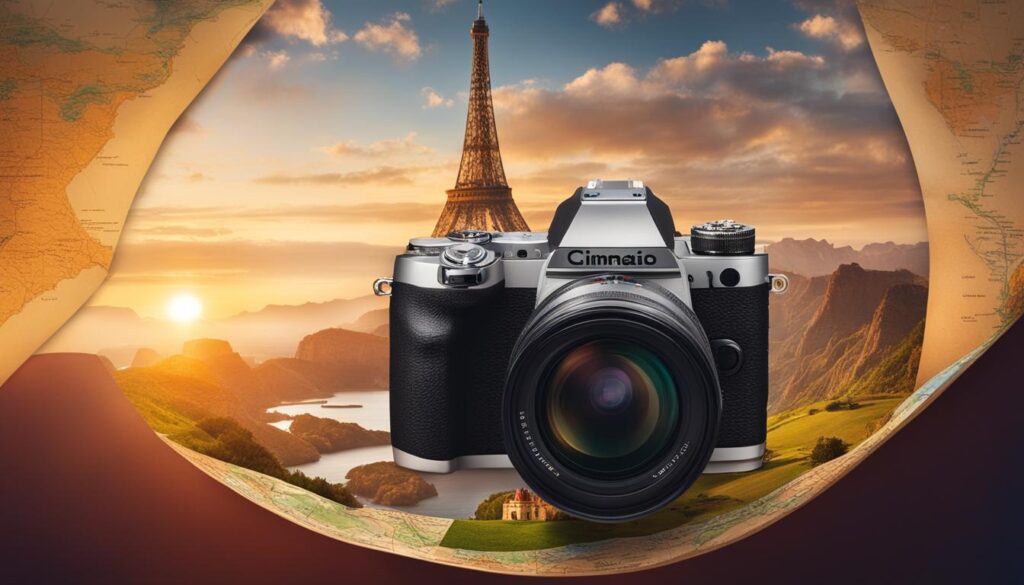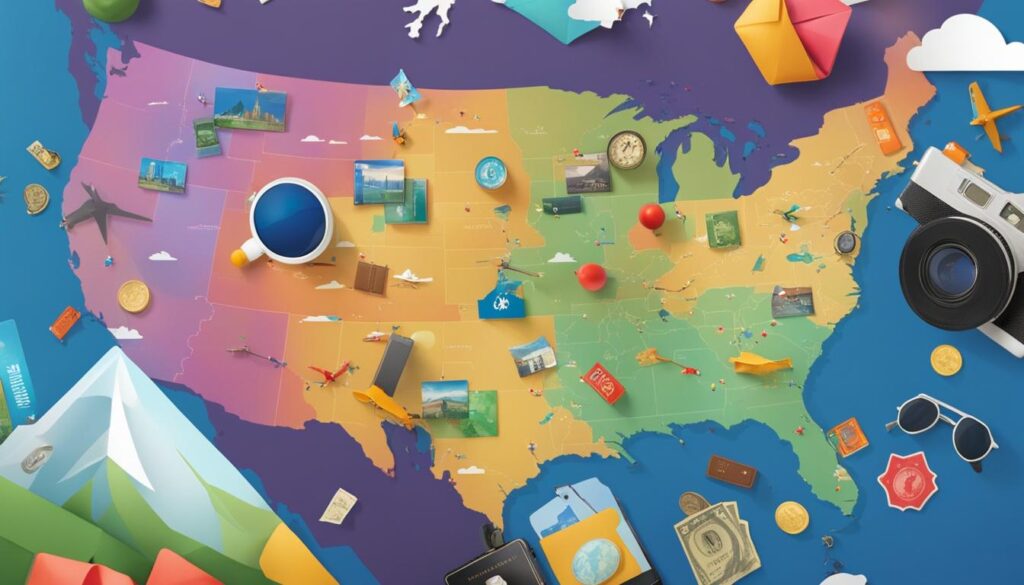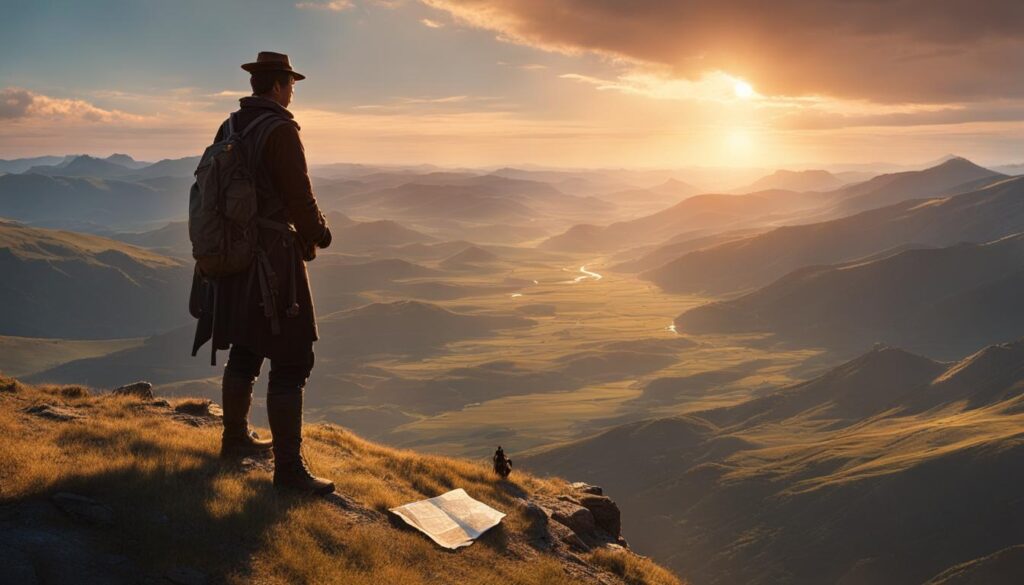We may earn money or products from the companies mentioned in this post.
Travel photography can be an incredible way to capture the world around us and create lasting memories. Whether you’re an amateur or a seasoned pro, there’s always room to improve your skills and take your photography to the next level. In this section, we will provide essential tips to enhance your travel photography skills, including techniques, ideas, and inspiration to help you capture stunning images during your travels.
Key Takeaways:
- Learn essential travel photography tips to enhance your skills.
- Discover techniques and ideas to find inspiration and capture stunning images.
- Invest in the right gear to set yourself up for success.
- Understand the importance of composition in travel photography.
- Explore various techniques such as capturing motion and using different perspectives.
Improve Your Composition: Travel Photography Composition Tips
Composition is key to creating compelling travel photographs. Well-composed travel photographs are visually appealing and can evoke emotions, memories or even transport the viewers to the destination. Here are some travel photography composition tips that can help you take your photography to the next level.
1. Rule of Thirds
The rule of thirds is one of the most fundamental composition techniques in photography. Imagine dividing your frame into thirds both horizontally and vertically, creating nine equal parts. The intersection of these lines should be your focal points to position your subject. Placing your subject off-center in one of the intersecting points creates a visually pleasing composition, which captures the viewer’s attention.
2. Leading Lines
Leading lines are a powerful tool that can lead the viewer’s eyes to the main subject of the photo. Leading lines can be straight lines like roadways or diagonal lines like the edge of a building. These lines can add depth and dimension to your travel photos.
3. Depth of Field
Sometimes, blurring the background can make the subject pop, adding depth to the image. You can achieve this effect by opening the aperture, allowing more light to enter the camera, and creating a shallow depth of field. This technique is especially useful when focusing on subjects up close.
4. Framing
Framing is using elements in the environment, such as a natural frame or a man-made one, to draw attention to the subject. This technique provides context, a sense of place to your image and can create a visually appealing composition.
5. Symmetry and Patterns
Symmetry and patterns in travel photography create balance and a sense of structure in an image. Look for symmetrical scenes that offer a natural balance of elements and repeating patterns to create visually stunning compositions.
By incorporating these travel photography composition tips into your workflow, you can elevate your photography skills and create compelling images that tell a story of your travels.
Capture the Right Moments: Travel Photography Techniques
In travel photography, capturing the right moments is essential to create stunning visuals that inspire and evoke a sense of wanderlust. To master this craft, it’s crucial to experiment and use different techniques to capture unique and compelling images. Here are some travel photography techniques you can use during your travels:
Capturing Motion
One way to add dynamism and energy to your travel photographs is by capturing motion. By using a slower shutter speed, you can create a sense of movement and blur in photos, which can create breathtaking results. To do this, set your camera to shutter priority mode and choose a slower shutter speed. Then, pan your camera in the direction of the movement while pressing the shutter button.
Using Different Perspectives
Another effective technique to enhance your travel photography is by experimenting with different perspectives. Instead of taking photos from eye level, try shooting from a low or high angle to create unique and memorable images. You can also try shooting from different angles, such as from the side or behind your subject, to add depth to your photos.
Utilizing Natural Light
Lighting can make or break a photograph, and this is especially true in travel photography. By utilizing natural light, you can add warmth, texture, and depth to your travel images. To make the most of natural light, try shooting during the golden hour, which is the hour after sunrise and the hour before sunset when the light is soft and warm. You can also experiment with backlighting, which can create stunning silhouettes and add drama to your photos.
By implementing these travel photography techniques, you can capture amazing moments during your travels and create stunning visuals that showcase your adventures. Remember to experiment, have fun, and let your creativity flow. Happy shooting!
Gear Up: Essential Travel Photography Equipment and Lighting Tips
Travel photography can be exhilarating, and having the right gear can make all the difference. Here are some essential pieces of equipment to consider before embarking on your next adventure:
| Item | Description |
|---|---|
| DSLR Camera | A good quality camera is essential for capturing high-quality images. Consider investing in a DSLR with interchangeable lenses for versatility. |
| Extra Batteries and Memory Cards | It’s always a good idea to have spare batteries and memory cards on hand, especially if you’ll be away from charging outlets for extended periods. |
| Tripod | A good quality tripod can help stabilize your shots and allow you to take long exposure shots without camera shake. |
| Polarizing Filter | A polarizing filter can help reduce glare and enhance color saturation, making your images pop. |
When it comes to lighting, natural light is often the best choice for travel photography. Here are some tips to help you make the most of the light available:
- Golden hour: The hour after sunrise and before sunset provides soft, warm light that can help create stunning images.
- Backlighting: Positioning your subject with the sun behind them can create a beautiful backlight effect.
- Diffused light: Overcast days can be great for photography, as the clouds act as a natural diffuser, creating soft, even light.
When natural light isn’t available or feasible, using artificial lighting can also be effective. Consider investing in a portable flash or reflector to help fill in shadows and improve your images.
Conclusion
By implementing the travel photography tips and techniques we’ve discussed, you can elevate your skills and capture amazing memories during your travels. Remember to experiment, be creative, and tell your visual stories through the lens of your camera.
As you continue to hone your travel photography skills, don’t forget to have fun and enjoy the journey. Whether you’re exploring a new city or venturing off the beaten path, there’s always something worth capturing. With the right mindset, equipment, and techniques, you can unleash your inner artist and create stunning travel photos that tell a story.
Thank you for joining us on this journey to master travel photography. We wish you all the best on your future travels and hope these tips will continue to inspire and guide you along the way.
FAQ
What are some essential travel photography tips?
Some essential travel photography tips include researching your destination, utilizing the golden hour, focusing on details, and experimenting with different angles and perspectives.
How can I improve my travel photography composition?
To improve your travel photography composition, you can try techniques like the rule of thirds, leading lines, framing your subjects, and creating balanced and visually appealing compositions.
What are some travel photography techniques I can use?
Some travel photography techniques you can use include capturing motion, utilizing different perspectives, playing with depth of field, and using natural light creatively.
What essential photography equipment should I have for travel photography?
For travel photography, it is recommended to have a versatile camera body, a wide-angle lens, a telephoto lens, a tripod, extra batteries, and memory cards. Additionally, consider carrying a travel-friendly camera bag to protect your gear.
How can I make the most of lighting in travel photography?
To make the most of lighting in travel photography, use the golden hour or blue hour for soft, warm light. Experiment with backlighting, sidelighting, and using natural and artificial light creatively to enhance your images.
Affiliate Disclosure: This post may contain affiliate links. If you purchase through our link, we may receive a small commission, but at no additional cost to you. For more information, please see our Disclosure statement.



